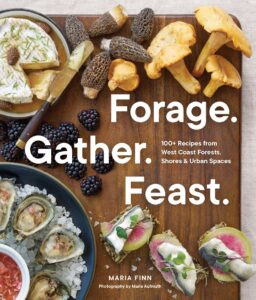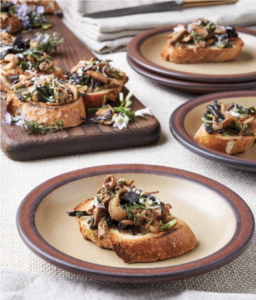Like the title so slyly indicates, Forage.Gather.Feast by Maria Finn is as mindful as it is streamlined. Chapters – The Coast, the Forest, the Edge and Urban Foraging – are designed with a single goal in mind: go outside and find some yummy food to eat. Bring it home and prepare it simply. You’ll benefit physically from eating local foods and spiritually from the joy of the process. Walking along a shore, a sidewalk, or a forest, Finn tells us, is all it takes to find, cook and eat delicious ingredients, many of them free for the taking.
A Foraging Cookbook for the Pleasure of Wild Foods
Finn’s cookbook celebrates the pleasure of wild foods, encouraging readers to commune with nature and find inspiration in her bounty. That translates to about 100 recipes for cooking over a fire or on a stovetop, recipes that consider oysters, seaweed, and herring (The Coast); chanterelles, green walnuts, and fiddlehead ferns (The Forest); loquats, roses and fireweed (The Edge and Urban Foraging).
Though no foraging is required (most of the ingredients can be found in well-stocked supermarkets, farmers’ markets or your very own backyard), there is a certain thrill from making Seaweed Pasta (page 21) with kombu you’ve harvested and cherry tomatoes you’ve grown yourself. Finn’s “foraging cookbook” offers brief primers on types of seaweed and reminders about best practices to SAFELY forage for mushrooms.
Some of the recipes are quite familiar and accessible – Truffle Pasta with Shaved Black Truffles (p. 136) is on countless restaurant menus during California’s rainy season and Preserved Lemons (p. 212) recipes can be found in cookbooks from Italy to Spain.
Other recipes feel more … novel. Pinecone Syrup (p. 155) makes its way into Piney Ice Cream (p. 155), Pine Scones with Huckleberry (p. 158) and Piney Chartreuse Swizzle cocktails (p. 160). While pine trees are evergreen, therefore edible all year, I am conditioned to think of pine as a winter flavor. I know, I know, I’m holding myself back…
I am most intrigued by recipes for Candy Cap Mushroom Shortbread Cookies (p. 149), Candied Pinecones (p. 157) and Bay Laurel Nut Hot Cocoa (p. 173). I can find these mushrooms at the farmers’ market and bay laurel nuts are all over the landscape in late fall, yet I hadn’t thought of these ingredients in this way before.
Recipes I Made
I made Seaweed, Seed, Oat and Nut Bread (p. 13) with a package of wakame from Mendocino’s Rising Tide Sea Vegetables. Finn thankfully adds no sweetener, reveling in the inherent flavors of the seaweed, oats, and nuts. I used up the last of my kombu and dried morels from the farmers’ market to make Morel Mushroom and Kombu Dashi (p. 18). It’s savory on its own or a first step to making miso soup and many other recipes. In honor of my mother-in-law, I made Campfire Porcini Risotto (p. 108) on my stovetop with thyme and sage from my garden. Nocino (p. 180), which I started in August, is still steeping. It needs more time to mellow.
Who Would Like This Cookbook
Finn’s cookbook book offers a holistic way to think about food and cooking. As in my review of Chími Nu’am, this cookbook got me thinking about how to cook with what is right in front of my eyes. To source ingredients from my land and the bounty of my community. To preserve today’s harvest for use as tomorrow’s larder.
Cherry blossoms will bloom soon, perfect for preserving (recipe on page 264) then making into Cherry Blossom Truffles (p. 263). (I’ll knock on my neighbor’s door in April when the blooms set up.) I don’t really have the time to forage, wash and dry my own seaweed, but I like seaweed’s flavor and cook with it often. Finn’s book is another reminder of the West’s abundance, that eating well can mean eating locally and simply. And a reminder to talk to your neighbors and get a barter system going.
With a soupçon of community-building, Forage.Gather.Feast is a deliciously local and sustainable approach to eating well.




